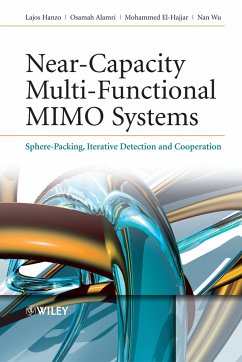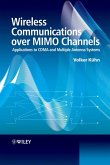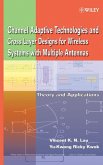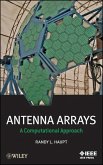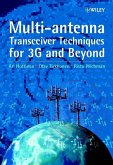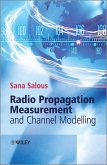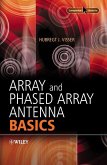Near-Capacity Multi-Functional MIMO Systems (eBook, PDF)
Sphere-Packing, Iterative Detection and Cooperation


Alle Infos zum eBook verschenken

Near-Capacity Multi-Functional MIMO Systems (eBook, PDF)
Sphere-Packing, Iterative Detection and Cooperation
- Format: PDF
- Merkliste
- Auf die Merkliste
- Bewerten Bewerten
- Teilen
- Produkt teilen
- Produkterinnerung
- Produkterinnerung

Hier können Sie sich einloggen

Bitte loggen Sie sich zunächst in Ihr Kundenkonto ein oder registrieren Sie sich bei bücher.de, um das eBook-Abo tolino select nutzen zu können.
Providing an all-encompassing self-contained treatment of Near-Capacity Multi-Functional MIMO Systems , the book starts by categorizing the family of Multiple-Input Multiple-Output (MIMO) schemes as diversity techniques, multiplexing schemes, multiple access arrangements and beam-forming techniques. Sophisticated coherent and low-complexity non-coherent MIMO receivers dispensing with channel estimation are considered in both classic and cooperation-aided scenarios. It is demonstrated that in the presence of correlated shadow-fading, cooperation-assisted systems may be expected to outperform…mehr
- Geräte: PC
- mit Kopierschutz
- eBook Hilfe
- Größe: 8.21MB
![Ultra Wideband Systems with MIMO (eBook, PDF) Ultra Wideband Systems with MIMO (eBook, PDF)]() Thomas KaiserUltra Wideband Systems with MIMO (eBook, PDF)110,99 €
Thomas KaiserUltra Wideband Systems with MIMO (eBook, PDF)110,99 €![Wireless Communications over MIMO Channels (eBook, PDF) Wireless Communications over MIMO Channels (eBook, PDF)]() Volker KuhnWireless Communications over MIMO Channels (eBook, PDF)114,99 €
Volker KuhnWireless Communications over MIMO Channels (eBook, PDF)114,99 €![Channel-Adaptive Technologies and Cross-Layer Designs for Wireless Systems with Multiple Antennas (eBook, PDF) Channel-Adaptive Technologies and Cross-Layer Designs for Wireless Systems with Multiple Antennas (eBook, PDF)]() Vincent K. N. LauChannel-Adaptive Technologies and Cross-Layer Designs for Wireless Systems with Multiple Antennas (eBook, PDF)141,99 €
Vincent K. N. LauChannel-Adaptive Technologies and Cross-Layer Designs for Wireless Systems with Multiple Antennas (eBook, PDF)141,99 €![Antenna Arrays (eBook, PDF) Antenna Arrays (eBook, PDF)]() Randy L. HauptAntenna Arrays (eBook, PDF)140,99 €
Randy L. HauptAntenna Arrays (eBook, PDF)140,99 €![Multi-antenna Transceiver Techniques for 3G and Beyond (eBook, PDF) Multi-antenna Transceiver Techniques for 3G and Beyond (eBook, PDF)]() Ari HottinenMulti-antenna Transceiver Techniques for 3G and Beyond (eBook, PDF)136,99 €
Ari HottinenMulti-antenna Transceiver Techniques for 3G and Beyond (eBook, PDF)136,99 €![Radio Propagation Measurement and Channel Modelling (eBook, PDF) Radio Propagation Measurement and Channel Modelling (eBook, PDF)]() Sana SalousRadio Propagation Measurement and Channel Modelling (eBook, PDF)98,99 €
Sana SalousRadio Propagation Measurement and Channel Modelling (eBook, PDF)98,99 €![Array and Phased Array Antenna Basics (eBook, PDF) Array and Phased Array Antenna Basics (eBook, PDF)]() Hubregt J. VisserArray and Phased Array Antenna Basics (eBook, PDF)123,99 €
Hubregt J. VisserArray and Phased Array Antenna Basics (eBook, PDF)123,99 €-
-
-
Dieser Download kann aus rechtlichen Gründen nur mit Rechnungsadresse in A, B, BG, CY, CZ, D, DK, EW, E, FIN, F, GR, HR, H, IRL, I, LT, L, LR, M, NL, PL, P, R, S, SLO, SK ausgeliefert werden.
- Produktdetails
- Verlag: John Wiley & Sons
- Seitenzahl: 738
- Erscheinungstermin: 11. Mai 2009
- Englisch
- ISBN-13: 9780470744703
- Artikelnr.: 37299208
- Verlag: John Wiley & Sons
- Seitenzahl: 738
- Erscheinungstermin: 11. Mai 2009
- Englisch
- ISBN-13: 9780470744703
- Artikelnr.: 37299208
IEEE Press Books on Related Topics. Preface. Acknowledgments. 1 Problem Formulation, Objectives and Benefits. 1.1 TheWirelessChannelandtheConceptofDiversity. 1.2 Diversity and Multiplexing Trade
offs in Multi
functionalMIMO Systems. 1.3 Coherent versus Non
coherent Detection for STBCs Using Co
located and Cooperative Antenna Elements. 1.4 HistoricalPerspectiveandState
of
the
ArtContributions. 1.5 IterativeDetectionSchemes andtheirConvergenceAnalysis. 1.6 Outline and Novel Aspects of the Monograph. Part I Coherent Versus Differential Turbo Detection of Sphere
packing
aided Single
user MIMO Systems. List of Symbols in Part I. 2 Space
Time Block Code Design using Sphere Packing. 2.1 Introduction. 2.2 Design Criteria for Space
Time Signals. 2.3 DesignCriteria forTime
correlatedFadingChannels. 2.4 Orthogonal Space
Time Code Design using SP. 2.5 STBC
SPPerformance. 2.6 ChapterConclusions. 2.7 ChapterSummary. 3 Turbo Detection of Channel
coded STBC
SP Schemes. 3.1 Introduction. 3.2 SystemOverview. 3.3 IterativeDemapping. 3.4 BinaryEXITChartAnalysis. 3.5 PerformanceofTurbo
detectedBit
basedSTBC
SPSchemes. 3.6 ChapterConclusions. 3.7 ChapterSummary. 4 Turbo Detection of Channel
coded DSTBC
SP Schemes. 4.1 Introduction. 4.2 Differential STBC using SP Modulation. 4.3 Bit
basedRSC
codedTurbo
detectedDSTBC
SPScheme. 4.4 ChapterConclusions. 4.5 ChapterSummary. 5 Three
stage Turbo
detected STBC
SP Schemes. 5.1 Introduction. 5.2 SystemOverview. 5.3 EXITChartAnalysis. 5.4 MaximumAchievableBandwidthEfficiency. 5.5 PerformanceofThree
stageTurbo
detectedSTBC
SPSchemes. 5.6 ChapterConclusions. 5.7 ChapterSummary. 6 Symbol
based Channel
coded STBC
SP Schemes. 6.1 Introduction. 6.2 SystemOverview. 6.3 Symbol
basedIterativeDecoding. 6.4 Non
binaryEXITChartAnalysis. 6.5 Performance of Bit
based and Symbol
based LDPC
coded STBC
SP Schemes. 6.6 ChapterConclusions. 6.7 ChapterSummary. Part II Coherent Versus Differential Turbo Detection of Single
user and Cooperative MIMOs. List of Symbols in Part II. 7 Linear Dispersion Codes: An EXIT Chart Perspective. 7.1 Introduction and Outline. 7.2 LinearDispersionCodes. 7.3 LinkBetweenSTBCs andLDCs. 7.4 EXIT
chart
basedDesignofLDCs. 7.5 EXIT
chart
basedDesignof IR
PLDCs. 7.6 Conclusion. 8 Differential Space
Time Block Codes: A Universal Approach. 8.1 Introduction and Outline. 8.2 SystemModel. 8.3 DOSTBCs. 8.4 DLDCs. 8.5 RSC
codedPrecoder
aidedDOSTBCs. 8.6 IRCC
coded Precoder
aided DLDCs. 8.7 Conclusion. 9 Cooperative Space
Time Block Codes. 9.1 Introduction and Outline. 9.2 Twin
layerCLDCs. 9.3 IRCC
coded Precoder
aided CLDCs. 9.4 Conclusion. Part III Differential Turbo Detection of Multi
functional MIMO
aided Multi
user and Cooperative Systems. List of Symbols in Part III. 10 Differential Space
Time Spreading. 10.1 Introduction. 10.2 DPSK. 10.3 DSTSDesignusingTwoTransmitAntennas. 10.4 DSTSDesignUsingFourTransmitAntennas. 10.5 ChapterConclusions. 10.6 ChapterSummary. 11 Iterative Detection of Channel
coded DSTS Schemes. 11.1 Introduction. 11.2 IterativeDetectionofRSC
codedDSTSSchemes. 11.3 Iterative Detection of RSC
coded and Unity
rate Precoded Four
antenna
aidedDSTS
SPSystem. 11.4 ChapterConclusions. 11.5 ChapterSummary. 12 Adaptive DSTS
assisted Iteratively Detected SP Modulation. 12.1 Introduction. 12.2 SystemOverview. 12.3 Adaptive DSTS
assisted SP Modulation. 12.4 VSF
basedAdaptiveRateDSTS. 12.5 Variable
code
rateIterativelyDetectedDSTS
SPSystem. 12.6 Results andDiscussion. 12.7 ChapterConclusionandSummary. 13 Layered Steered Space
Time Codes. 13.1 Introduction. 13.2 LSSTCs. 13.3 CapacityofLSSTCs. 13.4 IterativeDetectionandEXITChartAnalysis. 13.5 Results andDiscussion. 13.6 ChapterConclusions. 13.7 ChapterSummary. 14 DL LSSTS
aided Generalized MC DS
CDMA. 14.1 Introduction. 14.2 LSSTS
aidedGeneralizedMCDS
CDMA. 14.3 Increasing the Number of Users by Employing TD and FD Spreading. 14.4 IterativeDetectionandEXITChartAnalysis. 14.5 Results andDiscussion. 14.6 ChapterConclusions. 14.7 ChapterSummary. 15 Distributed Turbo Coding. 15.1 Introduction. 15.2 Background of Cooperative Communications. 15.3 DTC. 15.4 Results andDiscussion. 15.5 ChapterConclusions. 15.6 ChapterSummary. 16 Conclusions and Future Research. 16.1 SummaryandConclusions. 16.2 FutureResearchIdeas. 16.3 ClosingRemarks. A GrayMapping and AGM Schemes for SP Modulation of Size L=16. B EXIT Charts of Various Bit
based Turbo
detected STBC
SP Schemes. C EXIT Charts of Various Bit
based Turbo
detected DSTBC
SP Schemes. D LDCs' Ç for QPSK Modulation. E DLDCs' Ç for 2PAMModulation. F CLDCs' Ç1 and Ç2 for BPSK Modulation. G Weighting Coefficient Vectors " and ³. H GrayMapping and AGM Schemes for SP Modulation of Size L=16. Glossary. Bibliography. Index. Author Index.
IEEE Press Books on Related Topics. Preface. Acknowledgments. 1 Problem Formulation, Objectives and Benefits. 1.1 TheWirelessChannelandtheConceptofDiversity. 1.2 Diversity and Multiplexing Trade
offs in Multi
functionalMIMO Systems. 1.3 Coherent versus Non
coherent Detection for STBCs Using Co
located and Cooperative Antenna Elements. 1.4 HistoricalPerspectiveandState
of
the
ArtContributions. 1.5 IterativeDetectionSchemes andtheirConvergenceAnalysis. 1.6 Outline and Novel Aspects of the Monograph. Part I Coherent Versus Differential Turbo Detection of Sphere
packing
aided Single
user MIMO Systems. List of Symbols in Part I. 2 Space
Time Block Code Design using Sphere Packing. 2.1 Introduction. 2.2 Design Criteria for Space
Time Signals. 2.3 DesignCriteria forTime
correlatedFadingChannels. 2.4 Orthogonal Space
Time Code Design using SP. 2.5 STBC
SPPerformance. 2.6 ChapterConclusions. 2.7 ChapterSummary. 3 Turbo Detection of Channel
coded STBC
SP Schemes. 3.1 Introduction. 3.2 SystemOverview. 3.3 IterativeDemapping. 3.4 BinaryEXITChartAnalysis. 3.5 PerformanceofTurbo
detectedBit
basedSTBC
SPSchemes. 3.6 ChapterConclusions. 3.7 ChapterSummary. 4 Turbo Detection of Channel
coded DSTBC
SP Schemes. 4.1 Introduction. 4.2 Differential STBC using SP Modulation. 4.3 Bit
basedRSC
codedTurbo
detectedDSTBC
SPScheme. 4.4 ChapterConclusions. 4.5 ChapterSummary. 5 Three
stage Turbo
detected STBC
SP Schemes. 5.1 Introduction. 5.2 SystemOverview. 5.3 EXITChartAnalysis. 5.4 MaximumAchievableBandwidthEfficiency. 5.5 PerformanceofThree
stageTurbo
detectedSTBC
SPSchemes. 5.6 ChapterConclusions. 5.7 ChapterSummary. 6 Symbol
based Channel
coded STBC
SP Schemes. 6.1 Introduction. 6.2 SystemOverview. 6.3 Symbol
basedIterativeDecoding. 6.4 Non
binaryEXITChartAnalysis. 6.5 Performance of Bit
based and Symbol
based LDPC
coded STBC
SP Schemes. 6.6 ChapterConclusions. 6.7 ChapterSummary. Part II Coherent Versus Differential Turbo Detection of Single
user and Cooperative MIMOs. List of Symbols in Part II. 7 Linear Dispersion Codes: An EXIT Chart Perspective. 7.1 Introduction and Outline. 7.2 LinearDispersionCodes. 7.3 LinkBetweenSTBCs andLDCs. 7.4 EXIT
chart
basedDesignofLDCs. 7.5 EXIT
chart
basedDesignof IR
PLDCs. 7.6 Conclusion. 8 Differential Space
Time Block Codes: A Universal Approach. 8.1 Introduction and Outline. 8.2 SystemModel. 8.3 DOSTBCs. 8.4 DLDCs. 8.5 RSC
codedPrecoder
aidedDOSTBCs. 8.6 IRCC
coded Precoder
aided DLDCs. 8.7 Conclusion. 9 Cooperative Space
Time Block Codes. 9.1 Introduction and Outline. 9.2 Twin
layerCLDCs. 9.3 IRCC
coded Precoder
aided CLDCs. 9.4 Conclusion. Part III Differential Turbo Detection of Multi
functional MIMO
aided Multi
user and Cooperative Systems. List of Symbols in Part III. 10 Differential Space
Time Spreading. 10.1 Introduction. 10.2 DPSK. 10.3 DSTSDesignusingTwoTransmitAntennas. 10.4 DSTSDesignUsingFourTransmitAntennas. 10.5 ChapterConclusions. 10.6 ChapterSummary. 11 Iterative Detection of Channel
coded DSTS Schemes. 11.1 Introduction. 11.2 IterativeDetectionofRSC
codedDSTSSchemes. 11.3 Iterative Detection of RSC
coded and Unity
rate Precoded Four
antenna
aidedDSTS
SPSystem. 11.4 ChapterConclusions. 11.5 ChapterSummary. 12 Adaptive DSTS
assisted Iteratively Detected SP Modulation. 12.1 Introduction. 12.2 SystemOverview. 12.3 Adaptive DSTS
assisted SP Modulation. 12.4 VSF
basedAdaptiveRateDSTS. 12.5 Variable
code
rateIterativelyDetectedDSTS
SPSystem. 12.6 Results andDiscussion. 12.7 ChapterConclusionandSummary. 13 Layered Steered Space
Time Codes. 13.1 Introduction. 13.2 LSSTCs. 13.3 CapacityofLSSTCs. 13.4 IterativeDetectionandEXITChartAnalysis. 13.5 Results andDiscussion. 13.6 ChapterConclusions. 13.7 ChapterSummary. 14 DL LSSTS
aided Generalized MC DS
CDMA. 14.1 Introduction. 14.2 LSSTS
aidedGeneralizedMCDS
CDMA. 14.3 Increasing the Number of Users by Employing TD and FD Spreading. 14.4 IterativeDetectionandEXITChartAnalysis. 14.5 Results andDiscussion. 14.6 ChapterConclusions. 14.7 ChapterSummary. 15 Distributed Turbo Coding. 15.1 Introduction. 15.2 Background of Cooperative Communications. 15.3 DTC. 15.4 Results andDiscussion. 15.5 ChapterConclusions. 15.6 ChapterSummary. 16 Conclusions and Future Research. 16.1 SummaryandConclusions. 16.2 FutureResearchIdeas. 16.3 ClosingRemarks. A GrayMapping and AGM Schemes for SP Modulation of Size L=16. B EXIT Charts of Various Bit
based Turbo
detected STBC
SP Schemes. C EXIT Charts of Various Bit
based Turbo
detected DSTBC
SP Schemes. D LDCs' Ç for QPSK Modulation. E DLDCs' Ç for 2PAMModulation. F CLDCs' Ç1 and Ç2 for BPSK Modulation. G Weighting Coefficient Vectors " and ³. H GrayMapping and AGM Schemes for SP Modulation of Size L=16. Glossary. Bibliography. Index. Author Index.
